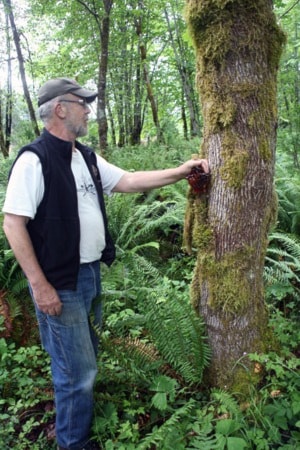Standing at the base of Mount Washington, in a grove of Douglas fir and red cedar trees, the steady drip of sap can be found in a clump of big leaf maples.
From mid-January until late February, the sap is collected from the 'sugar bush,' then taken to an evaporator/processor, bottled and sold as Vancouver Island's own maple syrup.
In an industry generally associated with Eastern Canada, maple syrup production on Vancouver Island is quickly becoming a burgeoning industry, explained forester Harold Macy.
Merville-based Macy and his wife Judy own Headquarters Creek Woodlot, a small sustainable forest on Crown land just off the Strathcona Parkway that provides timber to niche markets such as house logs and crossarms for power lines.
Macy also focuses on non-timber forest products such as mushrooms and berries as well as sap.
Recently, with Macy's help, maple syrup production was included as an acceptable farm crop under the BC Assessment Authority regulations.
He explained this means someone with an appropriate existing stands of native maple can now apply for farm status, opening the door for a significant increase of West Coast maple syrup production.
It also means increased economic spinoffs for farmers who focus on other primary agricultural production, such as beef or veggies who have maple trees on their land.
"This is really exciting to have this door opened," said Macy. "It's one of the most exciting things to have happened in forestry in years."
Macy noted now that rural landowners who have the appropriately sized maple trees, and who develop a management plan and apply for farm status can now be treated similar to those who produce cherries or apples.
He added that, with the change of regulations, there is a new sector for the interface between forestry and agriculture, and co-operative partnerships for production.
Depending on the season, one maple tree on the Island can produce between 80 and 90 litres of sap, and with a 38:1 L ratio, can translate into approximately two litres of maple syrup.
Once a tree is tapped, the sap is transported to an evaporator, boiled down to remove water, and filtered.
"The more you boil it down, the darker the colour, and the more flavour is produced," explained Macy, who said if the market increases, he foresees a potential for production co-operatives, or third parties who process the sap.
He described the flavours of syrups similar to wine — every region produces a different flavour with a different scent and taste. He noted West Coast maple syrup has a smoky flavour and many layers.
"Like a West Coast forest," he added.
Macy explained the Vancouver Island Sapsuckers organization as well as the Cowichan Valley are helping shed light on syrup production on the Island, as more than 2,000 people attended the Bigleaf Maple Syrup Festival this February at the BC Forest Discovery Centre in Duncan.
He said the event focused on tapping, syrup making tasting and demonstrating the variety of products that can be used with maple syrup, including candies and even maple pop, fabricated in Port Alberni.
Macy, who also works in forest education with the University of British Columbia research farms and teaches forestry courses on the Island, said one his former students, Gary Backlund, has even written a book on tapping the western maple.
Macy said for those in the forestry industry, maple syrup production now means a more immediate economic production from woodlots.
"It shows that you can have your forest, and you don't have to cut it down or wait another 80 years for your trees," he said.
For more information on Island sap or to order Backlund's book, visit www.blmaple.net or the BC Forest Discovery Centre at www.bcforestmuseum.com.
For more information on maple syrup production in the Comox Valley, contact Macy at hqcreek@telus.net.
photos@comoxvalleyrecord.com
